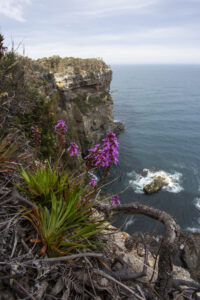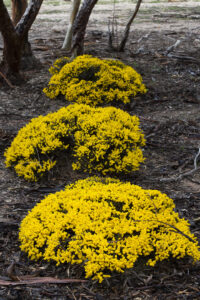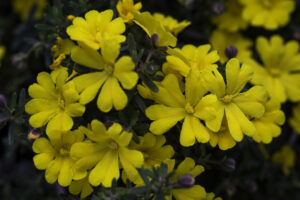
Aussie Gem’s – What’s still out there?
By Greg Bourke
When the home gardener thinks about Australian natives, they often think of compact or screening banksias, grevilleas and bottlebrushes, or other low maintenance plants such as kangaroo paws, grass trees, or lomandra, and often bird-attracting plants. Typically, they’re after something they can stick in the ground and forget about.
Of course, a lot of great Australian native plants have been introduced to cultivation or bred over the years. The range of cultivars, particularly in families like Proteaceae is fantastic but with gardeners prepared to spend more time tending to their plants in recent years, and with the ever-increasing demand for potted plants, for green walls, indoors, balconies and court yards, there are more opportunities to be explored with Australian natives.
I’ve been fortunate to travel extensively throughout Australia in search of weird and wonderful plants. Without exception, on every trip, no matter where I go, I see something that has potential for the horticultural industry. Whether it be a better form of a well-known plant, an obscure, poorly known genus, or something completely new to science, there’s always something that stands out to me. Of course, what may look great out in the scrub, might not necessarily translate to a marketable plant. But there’s only one way to find out!

We also need to be thinking about the future. With a changing climate, are there plants we can market as “Climate Ready”? Searching for, or breeding stock that is more resilient to extremes of temperature, and fluctuations in available moisture, are well worth considering. Then there is the pathogen problem. Pathogens like Phytophthora cinnamomi and Myrtle rust (Puccinia psidii) are devastating native plants but introducing or breeding resistant strains could be a great opportunity. Remember, our consumers are more aware than ever before, and they will choose a more environmentally sensible option if it is available.
Before you head out collecting, there are some important things to consider. Most important of all, is the need for a permit. No matter where you collect, you need to ensure you have the appropriate permits in place to do so. You need to ensure you have permission to transport that material too, and you need to ensure you have appropriate quarantine facilities to manage it when you get it back to your nursery. The last thing you want to do is infect your local area with a pathogen! You should also run the plant through a weed risk assessment process. It’s great to release a plant that is going to perform well for consumers, but not so well that it invades the streets! There are, of course, many other things to consider but it could be worth the effort.
What do I think has the potential to shine? I don’t think there are enough pages in this journal to cover them all, but the following are a few groups that have stood out for me in recent times.

Fabaceae is an enormous family, with Acacia alone containing almost 1000 species in Australia. There are some great wattles on the market but there are hundreds out there that have probably never been trialled. Of the peas, I love some of the blue flowers seen in Hovea and I still don’t think we’ve seen the best from the genus Kennedia. Despite many of the members of this family being short-lived, they’re often very showy at a small size, floriferous, and self-cleaning.

Dilleniaceae and, the genus Hibbertia. Hibbertia scandens is commonly cultivated and often used in commercial applications but this is a genus of almost 400 species. Most are shrubs, produce a dense cover of yellow flowers and are self-cleaning. One of the biggest challenges is that the petals often drop off too easily but there are so many spectacular, compact species out there, I’m sure there is the potential for some real gems in this genus.
The family Goodeniaceae is among my favourites. Another with its centre of diversity in Australia, there have been some real winners introduced to cultivation over the years, but just from a few species. The genera Brunonia, Dampiera and Lechenaultia produce some of the best blue flowers seen in Australia. Species occur from the alps to the driest deserts. Plant habit is from small annual herb to small shrub. They can be challenging in cultivation but with about 400 species, there are plenty of opportunities.

Lastly, Stylidiaceae and the genus Stylidium. Another diverse group of mostly short-lived herbs. Only a few of the almost 300 species have been released commercially but this is another with real potential for pot culture. Plus, it has the added attraction of its active pollination mechanism. Another genus found from the alps, swamps, deserts and tropics, to everywhere in between.
There are many others like Asteraceae and edibles like Solanaceae, and even Poaceae that have real potential in Australia and abroad. We’ve seen some spectacular Australian plants enter the market, but I think we’ve barely scratched the surface. Whilst it can be challenging and time consuming to collect and trial new material, the rewards can be great. I hope I’ve inspired some of you to get out and search for those hidden Aussie gems. If anyone needs a collector, get in touch!
